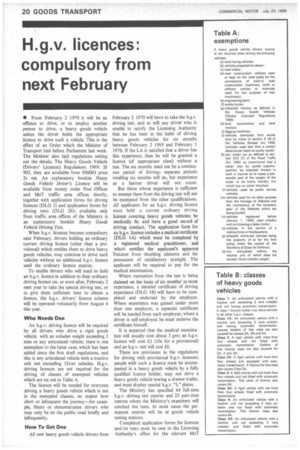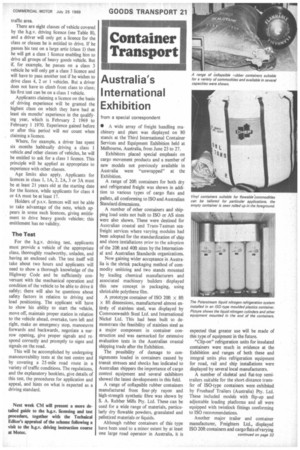H.g.v. licences: compulsory from next February
Page 22

Page 23

If you've noticed an error in this article please click here to report it so we can fix it.
• From February 2 1970 it will be an offence to drive, or to employ another person to drive, a heavy goods vehicle unless the driver holds the appropriate licence to drive such a vehicle. This is the effect of an Order which the Minister of Transport laid before Parliament last week. The Minister also laid regulations setting out the details. The Heavy Goods Vehicle (Drivers' Licences) Regulations 1969: SI 903, they are available from HMSO price 2s net. An explanatory booklet Heavy Goods Vehicle Driver's Licence will be available from money order Post Offices and MoT traffic area offices shortly, together with application forms for driving licences (DLG 1) and application forms for driving tests (DLG 26); available only from traffic area offices of the Ministry is an explanatory booklet Heavy Goods Vehicle Driving Test.
When h.g.v. licences become compulsory next February, drivers holding an ordinary current driving licence (other than a provisional) which entitles them to drive heavy goods vehicles, may continue to drive such vehicles without an additional h.g.v. licence until the ordinary licence expires.
To enable drivers who will need to hold an h.g.v. licence in addition to their ordinary driving licence on, or soon after, February 2 next year to take the special driving test, or to give them sufficient time to obtain a licence, the h.g.v. drivers' licence scheme will be operated voluntarily from August 4 this year.
Who Needs One
An h.g.v. driving licence will be required by all drivers who drive a rigid goods vehicle with an unladen weight exceeding 3 tons or any articulated vehicle; there is one exemption to the latter case, which has been added since the first draft regulations, and this is any articulated vehicle with a tractive unit not exceeding 15cwt unladen. H.g.v. driving licences are not required for the driving of classes of exempted vehicles which are set out in Table A.
The licence will be needed for everyone driving a heavy goods vehicle which is not in the exempted classes, no matter how short or infrequent the journey—for example, fitters or demonstration drivers who may only be on the public road briefly and infrequently.
How To Get One
February 2 1970 will have to take the h.g.v. driving test, and so will any driver who is unable to satisfy the Licensing Authority that he has been in the habit of driving heavy goods vehicles for six months between February 2 1969 and February 1 1970. If the LA is satisfied that a driver has this experience, then he will be granted a licence (of appropriate class) without a test. The six months need not be a continuous period of driving; separate periods totalling six months will do, but experience as a learner driver will not count.
But those whose experience is sufficient to exempt them from the driving test will not be exempted from the other qualifications. All applicants for an h.g.v. driving licence must hold a current ordinary driving licence covering heavy goods vehicles; be medically fit; and have a good record of driving conduct. The application form for an h.g.v. licence includes a medical certificate (DLG 1A) which must be completed by a registered medical practitioner, and _which certifies the applicant's apparent freedom from disabling ailments and his possession of satisfactory eyesight. The applicant will be required to pay for the medical examination.
Where exemption from the test is being claimed on the basis of six months' or more experience, a detailed certificate of driving experience (DLG I B) will have to be completed and endorsed by the employer. Where experience was gained under more than one employer, a separate certificate will be needed from each employer; where a driver is self-employed he must endorse the certificate himself.
It is expected that the medical examination will usually cost about 3 gns; an h.g.v. licence will cost LI (10s for a provisional) and an h.g.v. test will cost £6.
There are provisions in the regulations for driving with provisional h.g.v. licences; people with such a licence must be accompanied in a heavy goods vehicle by a fully qualified licence holder, may not drive a heavy goods vehicle towing a drawer trailer, and must display special h.g.v. "L" plates.
The Ministry has specified 64 full-time h.g.v. driving test centres and 25 part-time centres where the Ministry's examiners will conduct the tests. In most cases the permanent centres will be at goods vehicle testing stations.
Completed application forms for licences and /or tests must be sent to the Licensing Authority's office for the relevant MoT traffic area.
There are eight classes of vehicle covered by the h.g.v. driving licence (see Table B), and a driver will only get a licence for the class or classes he is entitled to drive. If he passes his test on a large artic (class I) then he will get a class I licence enabling him to drive all groups of heavy goods vehicle. But if, for example. he passes on a class 3 vehicle he will only get a class 3 licence and will have to pass another test if he wishes to drive class 4, 2 or 1 vehicles. But a driver does not have to climb from class to class; his first test can be on a class 1 vehicle.
Applicants claiming a licence on the basis of driving experience will be granted the highest class on which they have had at least six months' experience in the qualifying year, which is. February 2 1969 to February 1 1970. Experience gained before or after this period will not count when claiming a licence.
Where, for example, a driver has spent six months habitually driving a class 1 vehicle and other classes of vehicles, he will be entitled to ask for a class 1 licence. This principle will be applied as appropriate to experience with other classes.
Age limits also apply. Applicants for licences in class I, 1A, 2, 2A, 3 or 3A must be at least 21 years old at the starting date for the licence, while applicants for class 4 or 4A must be at least 17.
Holders of p.s.v. licences will not be able to take advantage of the note, which ap pears in some such licences, giving entitlement to drive heavy goods vehicles; this entitlement has no validity.
The Test
For the h.g.v. driving test, applicants must provide a vehicle of the appropriate class, thoroughly roadworthy, unladen, and having an enclosed cab. The test itself will take about two hours and applicants will need to show a thorough knowledge of the Highway Code and be sufficiently conversant with the mechanical operation and condition of the vehicle to be able to drive it safely; there will also he questions about safety factors in relation to driving and load positioning. The applicant will have to show his ability to start the vehicle, move off, maintain proper station in relation to the vehicle ahead, overtake, turn left and right, make an emergency stop, manoeuvre forwards and backwards, negotiate a narrow opening, give proper signals and respond correctly and promptly to signs and signals on the road.
This will be accomplished by undergoing manoeuvrability tests at the test centre and by covering a 25-mile road route in a variety of traffic conditions. The regulations, and the explanatory booklets, give details of this test, the procedures for application and appeal, and hints on what is expected as a driving standard.
















































































































